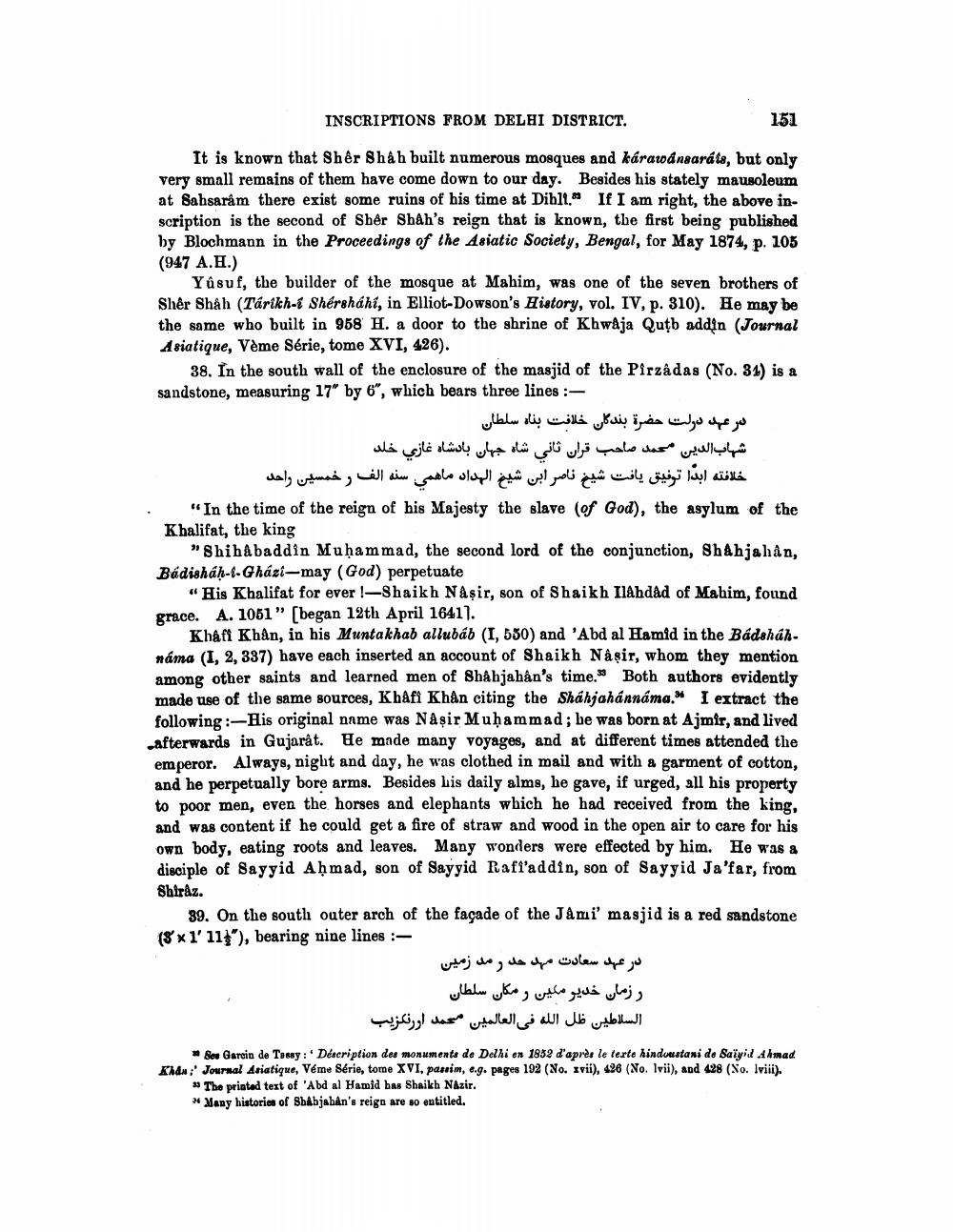________________
INSCRIPTIONS FROM DELHI DISTRICT.
151
It is known that Shêr Shâh built numerous mosques and kárawansaráts, but only very small remains of them have come down to our day. Besides his stately mausoleum at Sahsaram there exist some ruins of his time at Diblt." If I am right, the above inscription is the second of Sher Shah's reign that is known, the first being published by Blochmann in the Proceedings of the Asiatic Society, Bengal, for May 1874, p. 105 (947 A.H.)
Yûsuf, the builder of the mosque at Mahim, was one of the seven brothers of Sher Shah (Tarikh-i Shérsháhi, in Elliot-Dowson's History, vol. IV, p. 310). He may be the same who built in 958 H. a door to the shrine of Khwaja Qutb addin Journal Asiatique, Vème Série, tome XVI, 426).
38. In the south wall of the enclosure of the masjid of the Pirzadas (No. 31) is a sandstone, measuring 17" by 6", which bears three lines :
در عهد دولت حضرة بندگان خلافت بناه سلطان شهاب الدين محمد صاحب قران ثانی شاه جهان بادشاه غازي خلد خلافته ابدا توفيق يافت شيخ ناصر ابن شيخ الهداد ماهمي سنه الف وخمسين واحد
"In the time of the reign of his Majesty the slave (of God), the asylum of the Khalifat, the king
"Shihabaddin Muhammad, the second lord of the conjunction, ShAhjahân, Badishah-l-Gházi-may (God) perpetuate
"His Khalifat for ever 1-Shaikh Naşir, son of Shaikh Ilahdåd of Mahim, found grace. A. 1051" [began 12th April 1641).
Khaft Khan, in his Muntakhab allubáb (1,550) and 'Abd al Hamid in the Badshahnáma (I, 2, 337) have each inserted an account of Shaikh Naşir, whom they mention among other saints and learned men of Shahjahan's time. Both authors evidently made use of the same sources, Khafi Khan citing the Shahjahannama. I extract the following :-His original name was Naşir Muḥammad; be was born at Ajmir, and lived afterwards in Gujarat. He made many voyages, and at different times attended the emperor. Always, night and day, he was clothed in mail and with a garment of cotton. and he perpetually bore arms. Besides his daily alms, he gave, if urged, all his property to poor men, even the horses and elephants which he had received from the king, and was content if he could get a fire of straw and wood in the open air to care for his own body, eating roots and leaves. Many wonders were effected by him. He was a disciple of Sayyid Ahmad, son of Sayyid Rafi'addin, son of Sayyid Ja'far, from Shiraz.
89. On the south outer arch of the facade of the Jami' masjid is a red sandstone (8 *1'113'), bearing nine lines :
در عهد سعادت مهد حد رمد زمین رزمان خدیر مکین و مکان سلطان السلاطين ظل الله في العالمين محمد اورنگزیب
KM
* Soe Garcin de Tasay: 'Description des monuments de Delhi en 1852 d'après le texte hindustani de Saïyid Ahmad. ;' Journal Asiatique, Véme Série, tome XVI, passim, c.g. pages 192 (No. zvii), 426 (No. Ivii), and 428 (No. lviii). * The printed text of 'Abd al Hamid bas Shaikh Nazir.
Many histories of Shabjabân's reigo are so entitled.




